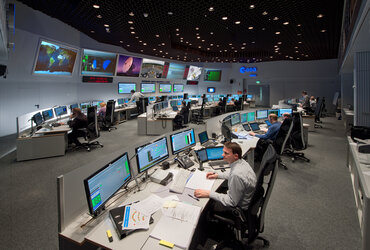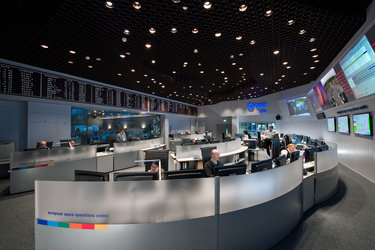ESA teams ready for Europe’s next weather satellite
Ground control teams are ready to shepherd Europe’s next weather satellite through its critical first days in orbit, ensuring it is working and healthy in the harsh environment of space.
On 15 July, a team of experts will be sitting ‘on console’ in the Main Control Room at ESA’s European Space Operations Centre, ESOC, in Darmstadt, Germany, watching intently as the latest Meteosat Second Generation satellite, MSG-4, separates from its Ariane launcher.
As with its three predecessors, information from the last of the MSG series is required for the ‘nowcasting’ of high-impact weather and for continuing climate research.
MSG satellites, dubbed Meteosat once operating, provide full-disc images over Europe and Africa every 15 minutes and ‘rapid scan’ imagery over Europe every five minutes.

They are operated by Eumetsat – the European Organisation for the Exploitation of Meteorological Satellites – and ESA is responsible for their design, development and in-orbit delivery.
Ariane flight VA224 is set for liftoff in a 37-minute window starting at 21:42 GMT (23:42 CEST) on Wednesday, 15 July. MSG-4 will separate from Ariane’s upper stage about 40 minutes after launch, a few minutes after its co-passenger, Embratel’s Star One C4 satellite.
Taking control

Separation marks the start of ‘LEOP’ – the launch and early orbit phase – when the satellite comes under control of the teams at ESOC, who will take it through a series of health checks and turn on some of the units including the instruments.
This is one of the most critical phases of any satellite’s life, and experts spanning a range of specialities, including mission operations, flight dynamics, software and ground stations, will work 24 hours per day to ensure MSG-4 is operating as it should.
“In many ways, it’s a text-book LEOP for us, and very similar to the services we provided for the first three MSG satellites,” says ESA flight director Nigel Head.
“Nonetheless, we are training as thoroughly for this as for any mission, and we will be especially engaged for the most critical steps, including the orbital manoeuvres and the ejection of the main imager covers.”
Establish a commanding link

During the 12-day LEOP, the satellite will fire its apogee motor four times to take it to its final geostationary orbit high above Europe, where it will be kept as a ‘hot backup’ for Eumetsat’s current Meteosat fleet.
“Even during the ride to space, MSG-4 will be switched on and sending us a continuous feed of live information on its status so we can keep a constant check on how it’s doing,” says Spacecraft Operations Manager Steve Foley.
“However, it is only when we are able to establish a commanding link, as soon as possible after separation from the Ariane launcher, that we can get going with our well-rehearsed operations.”
The first commands are expected to be sent about 41 minutes into flight, using the tracking station at Malindi, Kenya.
Intensive training
The mission control team have conducted numerous simulation training sessions using the ground systems and tracking stations that will enable engineers to control the satellite in space. Experts from ESA’s ESTEC technical centre in the Netherlands, Eumetsat and the satellite manufacturer, Thales Alenia Space, also trained to be ready for any possible contingency.
After separation, flight dynamics specialists will use radio signals and other data received from MSG-4 to assess the accuracy of the satellite’s orbit injection, determine its trajectory and orientation, and then compute the duration of the motor burns to reach its final destination over the course of the next 12 days.


Access the video
“We have up-to-date software to conduct our orbit analysis, but it’s interesting that this in turn is based on software developed nearly four decades ago for the very first geostationary missions supported by ESOC in the early 1970s,” says Xavier Marc, responsible for MSG-4 flight dynamics.
“This software is robust and reliable, because the laws of physics haven’t changed!”
When the satellite is approaching its final orbital location, control of MSG-4 will be transferred to Eumetsat. The handover, around 20 July, will be a very poignant event because this is the last in the MSG series and numerous current and former ESA and industrial support engineers have been involved in the programme over several decades.
“There will certainly be a celebration, and some of the old crew will reminisce about the early MSG LEOPs,” says Steve Foley, who was a young engineer when preparing MSG-1’s LEOP in 1998.


Access the video
“MSG-4 will be the 13th in-orbit delivery by ESOC of a weather satellite, an unparalleled string of successful operations dating back to Meteosat-1 in 1977,” notes Paolo Ferri, Head of Mission Operations at ESA.
“Our teams are ready, our tracking stations are ready and our ground systems are ready. We are looking forward to a smooth start for Europe’s next weather mission.”
About MSG-4
The MSG series of geostationary satellites helps to ensure the safety of lives, property and infrastructure through its critical input into the nowcasting of high-impact weather.
Renamed Meteosat-11 once in place, MSG-4 will ultimately bridge the gap between Meteosat-10 (launched in 2012) and the first Meteosat Third Generation satellites, expected to be launched in 2019 and 2021.
ESA was responsible for developing the MSG satellites to fulfil user and system requirements defined by Eumetsat, and for procuring recurrent satellites on its behalf. Eumetsat developed the ground systems to deliver products and services to users and to respond to their evolving needs. It also procured all launch services and operates the full system. The satellites were built by a European consortium led by Thales Alenia Space.














 Germany
Germany
 Austria
Austria
 Belgium
Belgium
 Denmark
Denmark
 Spain
Spain
 Estonia
Estonia
 Finland
Finland
 France
France
 Greece
Greece
 Hungary
Hungary
 Ireland
Ireland
 Italy
Italy
 Luxembourg
Luxembourg
 Norway
Norway
 The Netherlands
The Netherlands
 Poland
Poland
 Portugal
Portugal
 Czechia
Czechia
 Romania
Romania
 United Kingdom
United Kingdom
 Slovenia
Slovenia
 Sweden
Sweden
 Switzerland
Switzerland




































